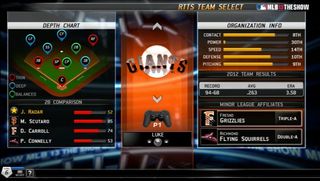
POSITION SELECTION
Though there are nine different positions fielded on the diamond, there are really only six actual positions to choose from. What you want to do with your career depends on a few factors. Do you want to play for your favorite team? Do you want to have an every day player, or do you want to pitch every five days? Do you just have a favorite position, and don’t mind where you end up in the MLB? These questions can help determine not just where you play on the field, but where you are given your first job.
Some teams have more pressing needs than others, and thus present a better opportunity for you to advance through the ranks faster. Other teams are so stocked at certain positions you might have trouble even cracking the everyday line-up in AA. If you have dreams of playing for your hometown team, it might be prudent to learn where they have the least amount of depth in the organization. By filling a key position, you become instantly more valuable, even with the low starting rating your created player will have.
We’ve taken the time to analyze all thirty MLB teams to give you an early indication as to where you might fit best at a given position.
AMERICAN LEAGUE
Every Position: Angels, White Sox, Astros
First Base: Twins, Blue Jays, Yankees, Orioles
Second Base: Twins, Royals
Third Base: Mariners, Royals, Tigers, Indians
Shortstop: Twins, Tigers, Blue Jays, Orioles
Catcher: Indians, Rays
Outfield: Rangers, Athletics, Twins, Indians, Yankes, Red Sox, Orioles
Pitcher (Starting, Relief): None
Closer: Every Team
NATIONAL LEAGUE
Every Position: Cubs, Marlins, Pirates, Brewers
First Base: Padres, Rockies, Diamondbacks, Phillies, Reds, Nationals, Braves
Second Base: Diamondbacks, Cardinals
Third Base: Giants, Phillies, Nationals, Braves
Shortstop: Rockies, Mets, Nationals, Braves
Catcher: Giants, Padres, Dodgers, Diamondbacks, Mets
Outfield: Dodgers, Cardinals, Reds, Phillies, Mets
Pitcher (Starting, Relief): Giants
Closer: Every Team
As you can see, there are plenty of openings throughout baseball where you can find a fit for the particular player you want to create. There are a few notes to take into consideration about this organizational chart. Just because a team lacks depth one or more positions overall doesn’t mean there isn’t an incumbent superstar already playing in the Major League. For instance, the Giants lack depth at both the catcher and pitcher positions. The Giants have one of the best young catchers in baseball (Buster Posey) playing for them, and there are no signs of his departing any time soon. Though the Giants’ rotation isn’t getting any younger, they do have a bonafide top three, which would be hard to crack under any circumstance. That’s not to say you shouldn’t make a pitcher for the Giants, or any other team for that matter. It’s just that becoming a standout will be more of a challenge than if you were to play somewhere else on the diamond.
It’s also important to recognize that as a prospect, you may not end your season (let alone your career) with the same team that drafted you. While the team you’re with at the end of the season will have the only bargaining rights to extend your contract (which will be for one year, every year until you break into the Bigs), they could easily move you at any point during the season to a team that’s loaded with talent at your position. So take the chart into advisement, but remember it’s just a guideline, not the rule.
